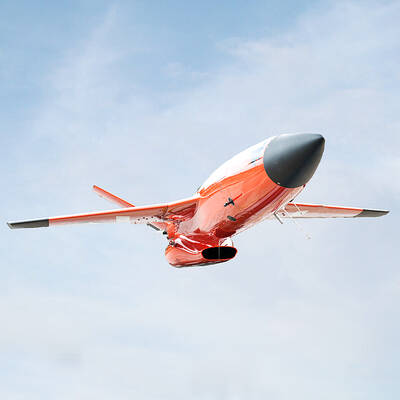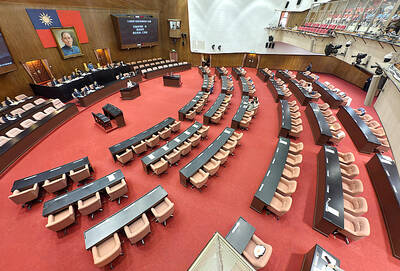President Ma Ying-jeou (馬英九) referred to Taiwan as a “province” yesterday while describing the sister-state relationship between Taiwan and Texas, rekindling the controversial issue of his perception of Taiwan’s status.
Ma told Texas Governor Rick Perry during a meeting at the Presidential Office that the country’s relationship with Texas was a close one.
“In 1988, Texas and Taiwan Province became sister states,” Ma said. “Over the past two years, we have engaged in many exchanges in technology, culture, education and agriculture.”
Ma thanked the Texas legislature for passing a resolution last year reaffirming the “sister state and sister province” relationship.
However, Ma’s description ran counter to the one stated in Resolution 81(R) HR 1593 passed by the Texas House of Representatives in June last year, which states: “Texas and Taiwan are celebrating the 21st anniversary of their Sister State relationship in June 2009.”
“Texas and Taiwan became Sister States on June 13, 1988, and today 11 jurisdictions within Texas enjoy similar ties with their Taiwanese counterparts ... the House of Representatives of the 81st Texas Legislature hereby commemorate the 21st anniversary of the signing of the Sister State agreement between Texas and Taiwan and extend sincere best wishes to all those who are engaged in strengthening Texas-Taiwan Sister relations; and, be it further rsolved that an official copy of this resolution be prepared for the Taipei Economic and Cultural Office in Houston as an expression of high regard by the Texas House of Representatives” it said.
The Taipei Economic and Cultural Office in Houston, however, refers to Taiwan as a “province” on its official Web site.
Titled “Regional Relationships,” the site says the “State of Texas established a sister-state relationship with Taiwan Province in 1988, and at present, ten Texas cities/county have sisterhood relationships with cities in Taiwan.”
Liu Shih-chung (劉世忠), a research fellow at the Taiwan Brain Trust think tank, said Ma’s logic made sense under the Republic of China (ROC) Constitution, which views China as part of its territory.
“But it is impractical and runs counter to political reality,” he said.
In the eyes of the Democratic Progressive Party (DPP), Liu said the ROC was long subjugated when the Chinese Nationalist Party (KMT) lost the Chinese civil war in 1949. For the DPP, Taiwan is an independent sovereignty whose current name is the ROC, he said.
Liu said he did not have any problem with the sister-state relationship between Taiwan and Texas in terms of trade. What worried him, however, was Ma’s backtracking to the former KMT administration’s “unrealistic” mindset that China is part of the ROC and the relationship between Taiwan and China is one of region to region.
Taiwan has relationships with 42 US states, the Arkansas-based Taiwan-United States Sister Relations Alliance says.
DPP spokesman Tsai Chi-chung (蔡其昌) said Taiwan is a sovereign county, not a province.
Ma was “belittling the country to such an extent that he is not qualified to be the country’s head,” Tsai said, adding that the president failed to protect the country’s dignity and was instead humiliating Taiwan before foreigners.
Ma sees Taiwan as part of China and all his policies stem from that position, Tsai said, adding that Taiwanese could not bear such remarks.
ADDITIONAL REPORTING BY RICH CHANG

CROSS-STRAIT COLLABORATION: The new KMT chairwoman expressed interest in meeting the Chinese president from the start, but she’ll have to pay to get in Beijing allegedly agreed to let Chinese Nationalist Party (KMT) Chairwoman Cheng Li-wun (鄭麗文) meet with Chinese President Xi Jinping (習近平) around the Lunar New Year holiday next year on three conditions, including that the KMT block Taiwan’s arms purchases, a source said yesterday. Cheng has expressed interest in meeting Xi since she won the KMT’s chairmanship election in October. A source, speaking on condition of anonymity, said a consensus on a meeting was allegedly reached after two KMT vice chairmen visited China’s Taiwan Affairs Office Director Song Tao (宋濤) in China last month. Beijing allegedly gave the KMT three conditions it had to

‘BALANCE OF POWER’: Hegseth said that the US did not want to ‘strangle’ China, but to ensure that none of Washington’s allies would be vulnerable to military aggression Washington has no intention of changing the “status quo” in the Taiwan Strait, US Secretary of Defense Pete Hegseth said on Saturday, adding that one of the US military’s main priorities is to deter China “through strength, not through confrontation.” Speaking at the annual Reagan National Defense Forum in Simi Valley, California, Hegseth outlined the US Department of Defense’s priorities under US President Donald Trump. “First, defending the US homeland and our hemisphere. Second, deterring China through strength, not confrontation. Third, increased burden sharing for us, allies and partners. And fourth, supercharging the US defense industrial base,” he said. US-China relations under

The Chien Feng IV (勁蜂, Mighty Hornet) loitering munition is on track to enter flight tests next month in connection with potential adoption by Taiwanese and US armed forces, a government source said yesterday. The kamikaze drone, which boasts a range of 1,000km, debuted at the Taipei Aerospace and Defense Technology Exhibition in September, the official said on condition of anonymity. The Chungshan Institute of Science and Technology and US-based Kratos Defense jointly developed the platform by leveraging the engine and airframe of the latter’s MQM-178 Firejet target drone, they said. The uncrewed aerial vehicle is designed to utilize an artificial intelligence computer

The Chinese Nationalist Party (KMT) caucus yesterday decided to shelve proposed legislation that would give elected officials full control over their stipends, saying it would wait for a consensus to be reached before acting. KMT Legislator Chen Yu-jen (陳玉珍) last week proposed amendments to the Organic Act of the Legislative Yuan (立法院組織法) and the Regulations on Allowances for Elected Representatives and Subsidies for Village Chiefs (地方民意代表費用支給及村里長事務補助費補助條例), which would give legislators and councilors the freedom to use their allowances without providing invoices for reimbursement. The proposal immediately drew criticism, amid reports that several legislators face possible charges of embezzling fees intended to pay